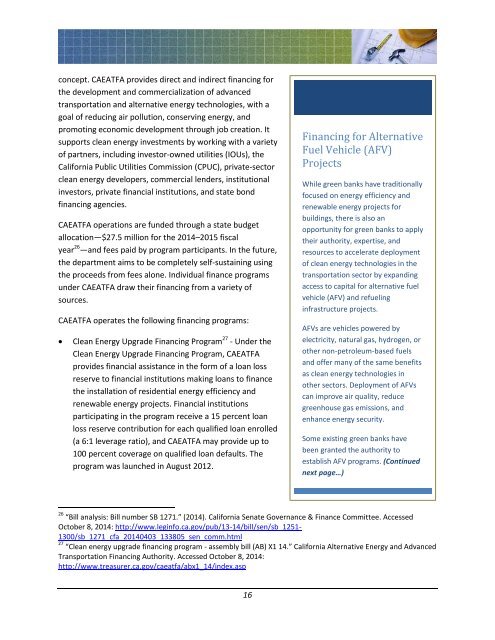bg4kk_f
bg4kk_f
bg4kk_f
Create successful ePaper yourself
Turn your PDF publications into a flip-book with our unique Google optimized e-Paper software.
concept. CAEATFA provides direct and indirect financing for<br />
the development and commercialization of advanced<br />
transportation and alternative energy technologies, with a<br />
goal of reducing air pollution, conserving energy, and<br />
promoting economic development through job creation. It<br />
supports clean energy investments by working with a variety<br />
of partners, including investor-owned utilities (IOUs), the<br />
California Public Utilities Commission (CPUC), private-sector<br />
clean energy developers, commercial lenders, institutional<br />
investors, private financial institutions, and state bond<br />
financing agencies.<br />
CAEATFA operations are funded through a state budget<br />
allocation―$27.5 million for the 2014–2015 fiscal<br />
year 26 ―and fees paid by program participants. In the future,<br />
the department aims to be completely self-sustaining using<br />
the proceeds from fees alone. Individual finance programs<br />
under CAEATFA draw their financing from a variety of<br />
sources.<br />
CAEATFA operates the following financing programs:<br />
<br />
Clean Energy Upgrade Financing Program 27 - Under the<br />
Clean Energy Upgrade Financing Program, CAEATFA<br />
provides financial assistance in the form of a loan loss<br />
reserve to financial institutions making loans to finance<br />
the installation of residential energy efficiency and<br />
renewable energy projects. Financial institutions<br />
participating in the program receive a 15 percent loan<br />
loss reserve contribution for each qualified loan enrolled<br />
(a 6:1 leverage ratio), and CAEATFA may provide up to<br />
100 percent coverage on qualified loan defaults. The<br />
program was launched in August 2012.<br />
Financing for Alternative<br />
Fuel Vehicle (AFV)<br />
Projects<br />
While green banks have traditionally<br />
focused on energy efficiency and<br />
renewable energy projects for<br />
buildings, there is also an<br />
opportunity for green banks to apply<br />
their authority, expertise, and<br />
resources to accelerate deployment<br />
of clean energy technologies in the<br />
transportation sector by expanding<br />
access to capital for alternative fuel<br />
vehicle (AFV) and refueling<br />
infrastructure projects.<br />
AFVs are vehicles powered by<br />
electricity, natural gas, hydrogen, or<br />
other non-petroleum-based fuels<br />
and offer many of the same benefits<br />
as clean energy technologies in<br />
other sectors. Deployment of AFVs<br />
can improve air quality, reduce<br />
greenhouse gas emissions, and<br />
enhance energy security.<br />
Some existing green banks have<br />
been granted the authority to<br />
establish AFV programs. (Continued<br />
next page…)<br />
26 “Bill analysis: Bill number SB 1271.” (2014). California Senate Governance & Finance Committee. Accessed<br />
October 8, 2014: http://www.leginfo.ca.gov/pub/13-14/bill/sen/sb_1251-<br />
1300/sb_1271_cfa_20140403_133805_sen_comm.html<br />
27 “Clean energy upgrade financing program - assembly bill (AB) X1 14.” California Alternative Energy and Advanced<br />
Transportation Financing Authority. Accessed October 8, 2014:<br />
http://www.treasurer.ca.gov/caeatfa/abx1_14/index.asp<br />
16


